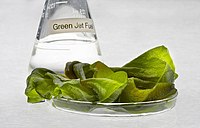
Photo from wikipedia
Hydrothermal liquefaction is a promising technology to upgrade wet organic waste into a biocrude oil for diesel or jet fuel; however, this process generates an acid-rich aqueous phase which poses… Click to show full abstract
Hydrothermal liquefaction is a promising technology to upgrade wet organic waste into a biocrude oil for diesel or jet fuel; however, this process generates an acid-rich aqueous phase which poses disposal issues. This hydrothermal liquefaction aqueous phase (HTL-AP) contains organic acids, phenol, and other toxins. This work demonstrates that Y. lipolytica as a unique host to valorize HTL-AP into a variety of co-products. Specifically, strains of Y. lipolytica can tolerate HTL-AP at 10% in defined media and 25% in rich media. The addition of HTL-AP enhances production of the polymer precursor itaconic acid by 3-fold and the polyketide triacetic acid lactone at least 2-fold. Additional co-products (lipids and citric acid) were produced in these fermentations. Finally, bioreactor cultivation enabled 21.6 g/L triacetic acid lactone from 20% HTL-AP in mixed sugar hydrolysate. These results demonstrate the first use of Y. lipolytica in HTL-AP valorization toward production of a portfolio of value-added compounds.
Journal Title: Bioresource technology
Year Published: 2020
Link to full text (if available)
Share on Social Media: Sign Up to like & get
recommendations!